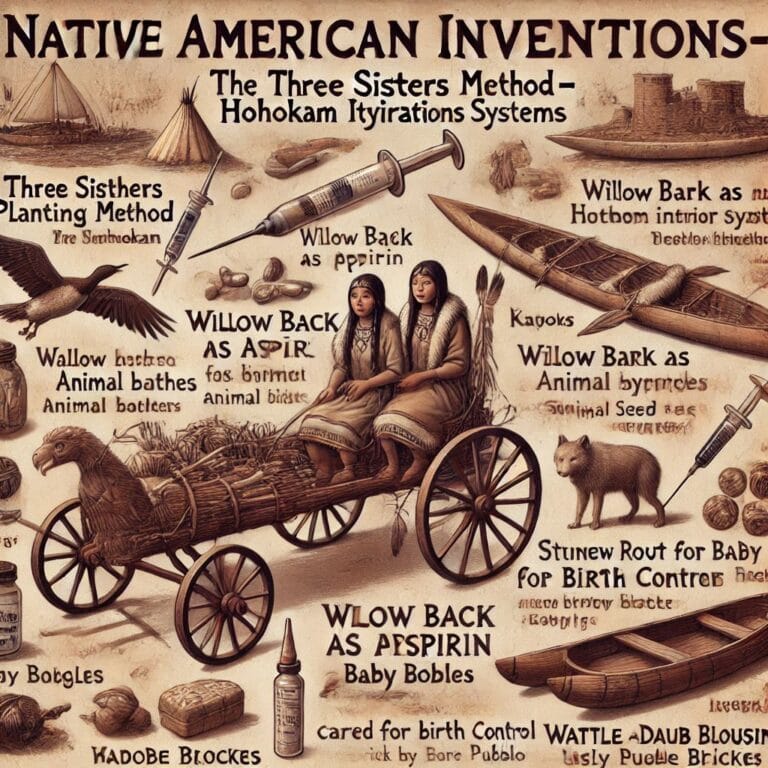Fire is a force of nature that has both fascinated and frightened humans for centuries, but it has played an important for human development & survival. We use fire to cook food, warm our homes, light candles, shape metals, and use it in many different forms, It is impossible to imagine a world without fire, until the discovery and control of fire that humans were able to take the first steps toward civilization. In this blog post, we will explore the invention of fire, its impact on human life, and how it has shaped our world today.
The invention of fire is considered to be one of the most important events in human history. The exact details of how the fire was first discovered are unknown, but it is believed that our ancestors first witnessed naturally occurring fires caused by lightning strikes or volcanic eruptions. Later on, humans learn to produce fire by rubbing two stones together.
This was an accidental discovery around 1.5 million years ago that early humans learned to control fire for their own purposes. The history of fire and the ability to control it was found long back before the evolution of modern humans. As there is no stronger evidence before homo erectus, homo erectus is credited for the first use of fire and its controlled use.
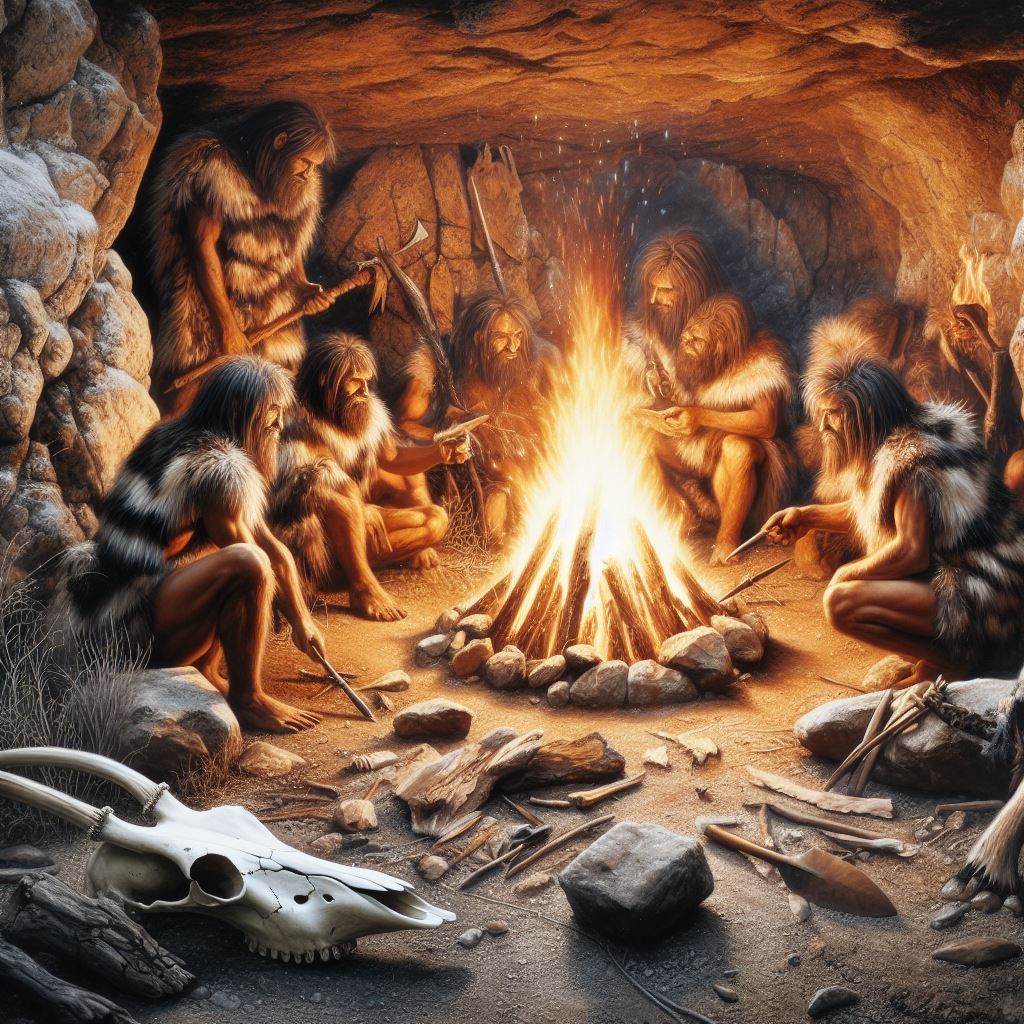
What is Fire
How Fire was Discovered (Early Human Control)
Human ancestors like homo erectus discovered fire through natural events like volcanic eruptions, wildfire, or lightning. Pieces of evidence of the question “When was fire invented?” are found in many places like- fire pits found in Africa, cave settings in Europe, and other colder climates. The ability to create and control fire was a dramatic change in the habits of early humans, earlier human was frightened by this natural force, but the ability to use it as a tool for important things like generating heat and light made it possible to cook food and simultaneously increase the variety and availability of nutrients. It also reduces disease by killing pathogenic microorganisms.
Early Evidence of Fire Control
It is very difficult to distinguish between wildfires and similar fires started by humans. We can find some of clues in Australia, Martu people used fire as a sophisticated tool to manage vegetation. By strategically setting controlled burns, they encouraged the growth of desired plant species, cleared land for hunting and gathering, and prevented destructive wildfires.
1.8 Million Years Ago:
Koobi Fora, Kenya: Reddened soil could be explained by exposure to fire, although natural processes like heat from volcanic activity can also cause similar coloration. Fractured animal bones with cut marks were also found, Some researchers believe these marks may have been made with heated tools, hinting at early attempts at cooking. However, other interpretations of the marks exist.
Dating: The sediments containing these finds are estimated to be around 1.8 million years old, placing them among the earliest potential evidence of fire control by Homo erectus. This dating is based on various methods, including magnetostratigraphy, which analyzes Earth’s magnetic field shifts in rock layers.
Science Direct- Koobi fora Kenya Evidence of Fire
1.42 Million Years Ago:
Chesowanja, Kenya: Discovery of red clay shards with charring and heat fractures, hinting at exposure to fire. The presence of early stone tools alongside the burnt clay adds context, suggesting human activity in the vicinity. Imagine our ancestors, toolmakers, and curious explorers, encountering the dance of flames.
Dating: The electron spin resonance (ESR) scientific method analyzes the “fingerprint” of burnt material, revealing its age. In Chesowanja, ESR helped scientists estimate the charred clay’s antiquity, taking us back to a distant chapter.
Potassium-argon dating technique analyzes volcanic ash layers found within the same sediments as the burnt clay, providing independent confirmation of the timeframe. It’s like piecing together a puzzle to understand the past.
1 Million Years Ago:
Wonderwerk Cave, South Africa:
Wonderwerk Cave holds some of the oldest evidence of controlled fire use by early hominins. Archaeological evidence suggests that fire was used within the cave environment as far back as 1 million years ago. Sediment layers within the cave contain ashes, charcoal, and burnt materials, indicating recurring use of fire over extended periods.
Heaps of burnt ash, charred wood, and heat-cracked tools paint a picture of controlled fire use by Homo erectus.
Dating: Luminescence dating on burnt flints and electron spin resonance (ESR) spectroscopy on organic material provide the timeframe.
Million-year-old ash hints at origin of Cooking-Nature Article
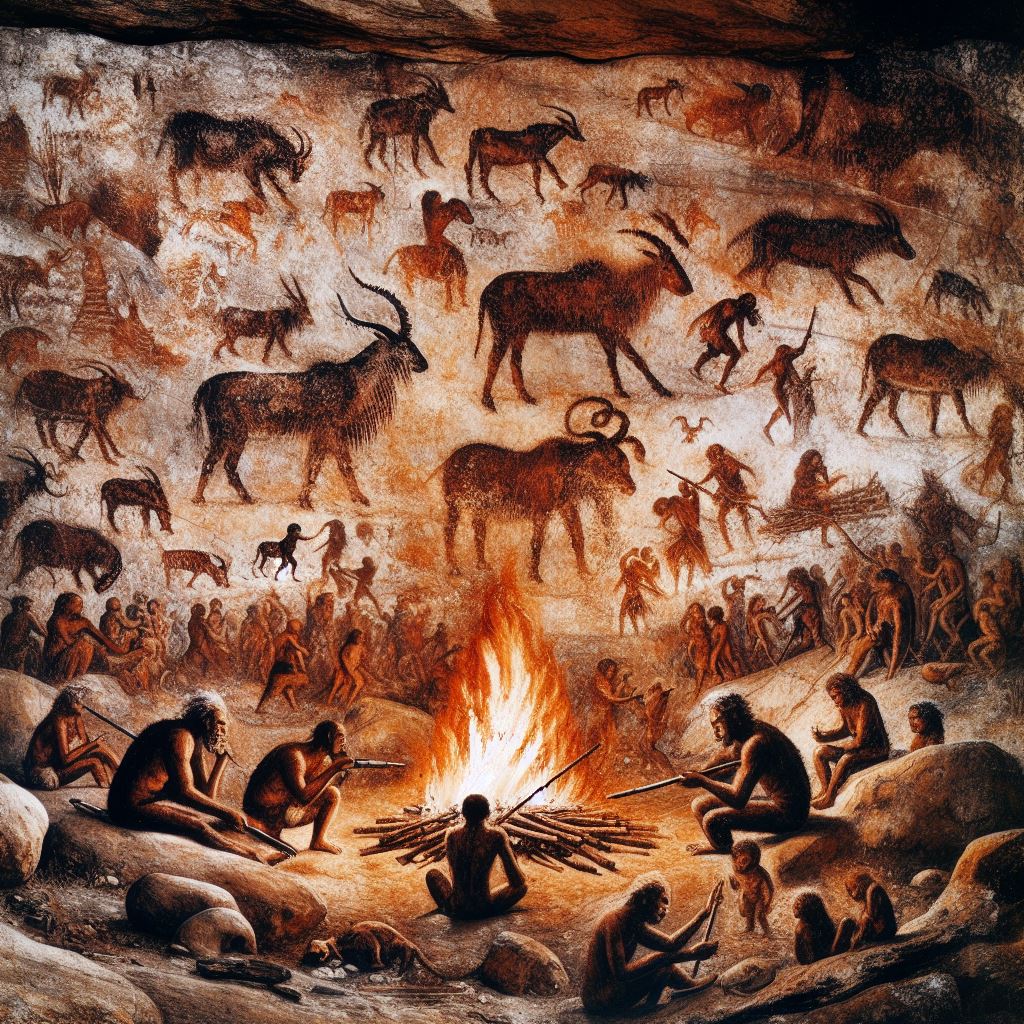
780,000 Years Ago:
Gesher Benot Ya’aqov, Israel: Archaeologists discovered charred plant remains and burnt bones at the site. The presence of burnt materials alongside stone tools indicates intentional fire control and use by early humans. These findings suggest deliberate exposure to fire. Imagine Homo erectus, toolmakers and explorers, encountering fire and perhaps even experimenting with its uses.
Dating: Electron spin resonance (ESR) spectroscopy on burnt material and uranium-series dating on animal teeth establish the age.
500,000 Years Ago:
Zhoukoudian, China: Archaeologists discovered hearths containing layers of ash and burnt animal bones at Zhoukoudian. These findings indicate areas where controlled fires were consistently used by Homo erectus. The presence of burnt animal bones suggests that fire was utilized for cooking and food preparation, altering the way early humans processed and consumed food.
The evidence of hearths with layers of ash points to fire usage not only for cooking but also for providing warmth within living spaces. Consistent fire usage suggests that Homo erectus had a systematic understanding of fire control and maintenance.
Dating: Uranium-series dating on animal teeth and paleomagnetic analysis of sediments provide the chronological framework.
Evidence of use fire at Zhoukoudian, China
400,000 Years Ago:
Vértesszőlős, Hungary: Archaeologists discovered hearths containing layers of ash and burnt animal bones at Vértesszőlős, indicating areas where fire was regularly used by Homo heidelbergensis. The presence of these hearths with burnt remains provides strong evidence of fire’s consistent utilization for warmth and food preparation within the ancient human settlement
Dating: Potassium-argon dating on volcanic ash layers and paleomagnetic analysis of sediments establish the timeframe.
Evidence of fire use (Wikipedia)
300,000-400,000 Years Ago:
Qesem Cave, Israel:
Archaeologists unearthed burnt flints and layers of ash within Qesem Cave, indicating evidence of controlled fire use by early human populations. The presence of burnt materials suggests deliberate exposure to fire, potentially for various purposes such as heating, cooking, or tool alteration.
Cooked animal bones found at the site hint at the practice of cooking by ancient humans inhabiting Qesem Cave. The evidence of burnt and modified bones suggests that early humans processed and consumed meat cooked over controlled fires, enhancing its digestibility and nutritional value.
The archaeological findings at Qesem Cave are associated with Homo erectus or potentially early Homo sapiens, indicating that these ancient human species were likely responsible for the controlled use of fire.
Dating: Electron spin resonance (ESR) spectroscopy on burnt material and uranium-series dating on animal teeth determine the age.
Science Direct- Fire use at Qesem Cave, Israel
250,000 Years Ago:
Abrigo de la Quebrada, Spain: The archaeological site linked to Homo heidelbergensis reveals hearths with burnt remnants, establishing a direct connection between this ancient human species and deliberate fire utilization. The discovery of burnt wood and animal bones within these hearths signifies purposeful fire management by Homo heidelbergensis, likely for fuel and cooking. The recurring presence of these hearths implies sustained and intentional fire control, showcasing the extended period during which Homo heidelbergensis populations actively maintained and used fire for various essential purposes.
Dating: Uranium-series dating on animal teeth and paleomagnetic analysis of sediments provide the chronological framework.
Ongoing Debate: Sites in Europe and Africa suggest dates exceeding 1 million years for controlled fire use, but these findings face scrutiny and require further verification.
Fire use at Abrigo de la Quebrada, Spain (Nature)
How did humans first make a fire?
Friction:
Rubbing or spinning one object against another to generate heat through friction. One common method was the bow drill, where a bow was used to rotate a wooden spindle against a baseboard, creating enough friction to ignite a dry tinder.
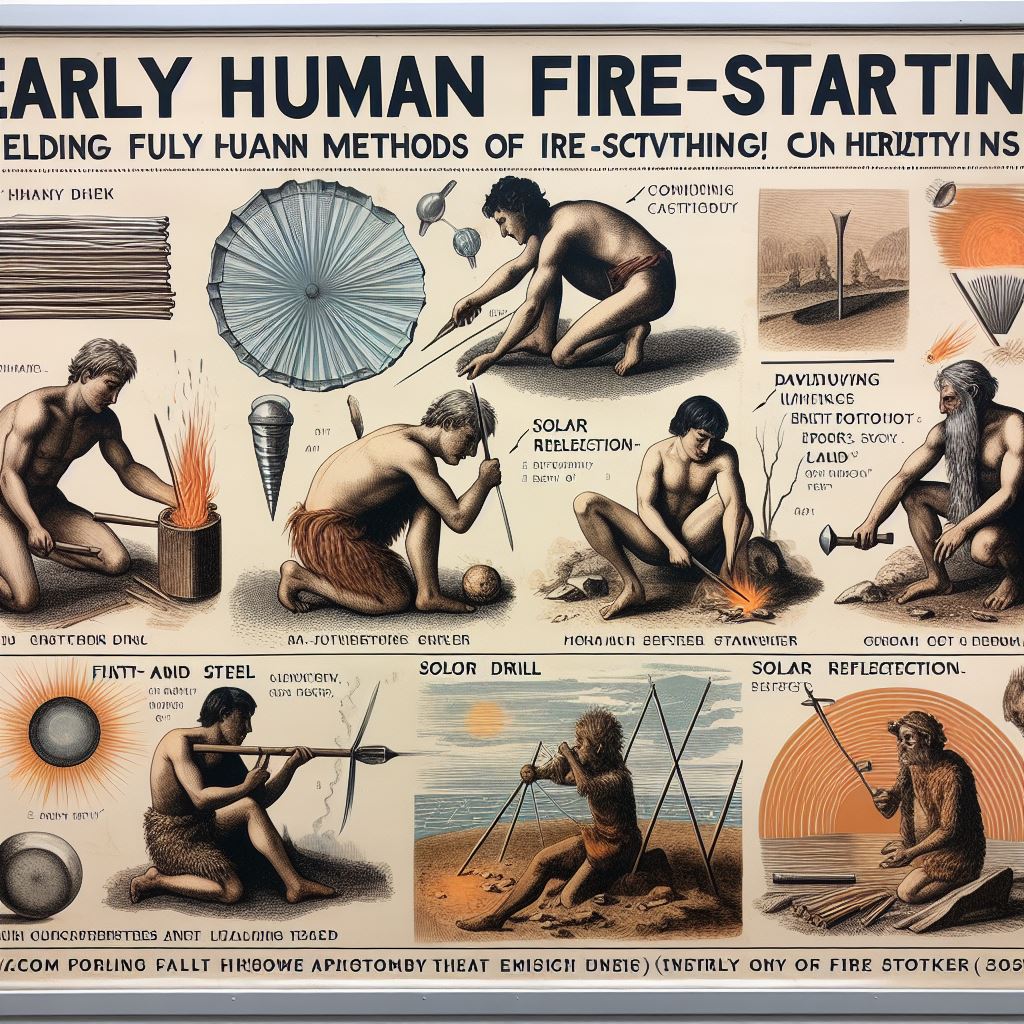
Flint and Steel:
Striking a piece of flint or similar hard rock against a piece of steel to create sparks. These sparks could then be directed onto a bed of tinder to start a fire. It requires proper striking technique and suitable material.
Fire by Percussion:
By striking these hard rocks against another hard object, early humans discovered they could create sparks capable of igniting tinder. This technique, often using naturally occurring minerals, demonstrates their ability to harness the natural world’s hidden potential.
Solar Ignition:
Focusing sunlight onto dry tinder using a lens or curved reflective surface to generate enough heat for ignition. This Technique requires direct sunlight, proper focus, and patience as it can take time to generate enough heat to start a fire.
Fire from Natural Sources:
Early humans took advantage of natural sources of fire, such as wildfires, lightning, meteor impacts, or lava flows, they used slow-burning substances to capture and maintain fire for their use.
Fire by Chemical Reactions:
Using certain chemicals or materials that could spontaneously ignite when combined, like potassium permanganate and glycerin.
Later Human Control
Applications of Fire
The invention of fire has initiated a profound transformation in human existence. It unlocked greater nutrition from food and frosting brain development. It also granted protection, and warmth and allowed us to venture into new territories.
Cooking:
Fire allowed early humans to cook their food. Cooking food not only made it safer to eat by killing pathogens and parasites but also made it more digestible, leading to increased nutrient absorption. Fire plays a significant role in human evolution as it is responsible for early human brain development and overall health making fire.

Warmth:
Fire provided warmth during cold weather and at night, allowing early humans to survive in different climates and regions that would otherwise have been challenging to inhabit. Early humans inhabited regions with harsh winters, evidenced by their settlements in places like Europe and northern Asia. The presence of hearths and fire-related artifacts in these areas indicates their reliance on fire for warmth during colder seasons.
Protection:
Fire served as a deterrent against predators, as many wild animals are wary of fire and would keep a safe distance from it. Observations of contemporary wildlife reveal an aversion to fire. Many animals, especially those without familiarity with fire, tend to avoid approaching flames due to instinctual fear and the potential for harm. While direct archaeological evidence is scarce, the behavior of modern wildlife near fires provides indirect support for early humans’ use of fire as a predator deterrent.
Tool-Making:
The fire was instrumental in making early human tools and weapons. For example, heating stones and then rapidly cooling them with water (quenching) allowed them to shape stones into more effective tools, such as arrowheads and blades.
Light:
Fire provided light during the night, which extended their active hours and allowed them to engage in various activities after sunset.
Social and Ritual Purposes:
The fire became a focal point for early human communities. Gathering around the fire facilitated social interaction, storytelling, and the passing down of knowledge and culture. It played a significant role in early human rituals and ceremonies.

Aboriginal Australians have gathered around smoking fires for storytelling, passing down knowledge from generation to generation. Festivals and celebrations around fires mark significant events in societies. For instance, bonfires during festivals like Diwali in India or Beltane in Celtic cultures symbolize renewal and community spirit. Fires play a central role in ceremonies, such as weddings, where they symbolize unity, purification, and the beginning of a new phase in life
Land Management:
Early humans likely used fire to manage landscapes and promote the growth of certain plants for food and other resources. The Martu people of Australia, particularly in the Western Desert practice “firestick farming,” a method involving controlled burning at specific times of the year to maintain and shape the landscape.
Use of Fire in Wars
use of fire in wars has a long history, fire was the basis of all thermal weapons. The use of fire to burn Troy by Greek soldiers who hid in the wooden horse during the Trogen war. The fire was also used to burn ships. The invention of gunpowder in China takes it to the next level. There are numerous modern applications of fire in warfare like flamethrowers, hand-thrown bombs, cannons & guns.
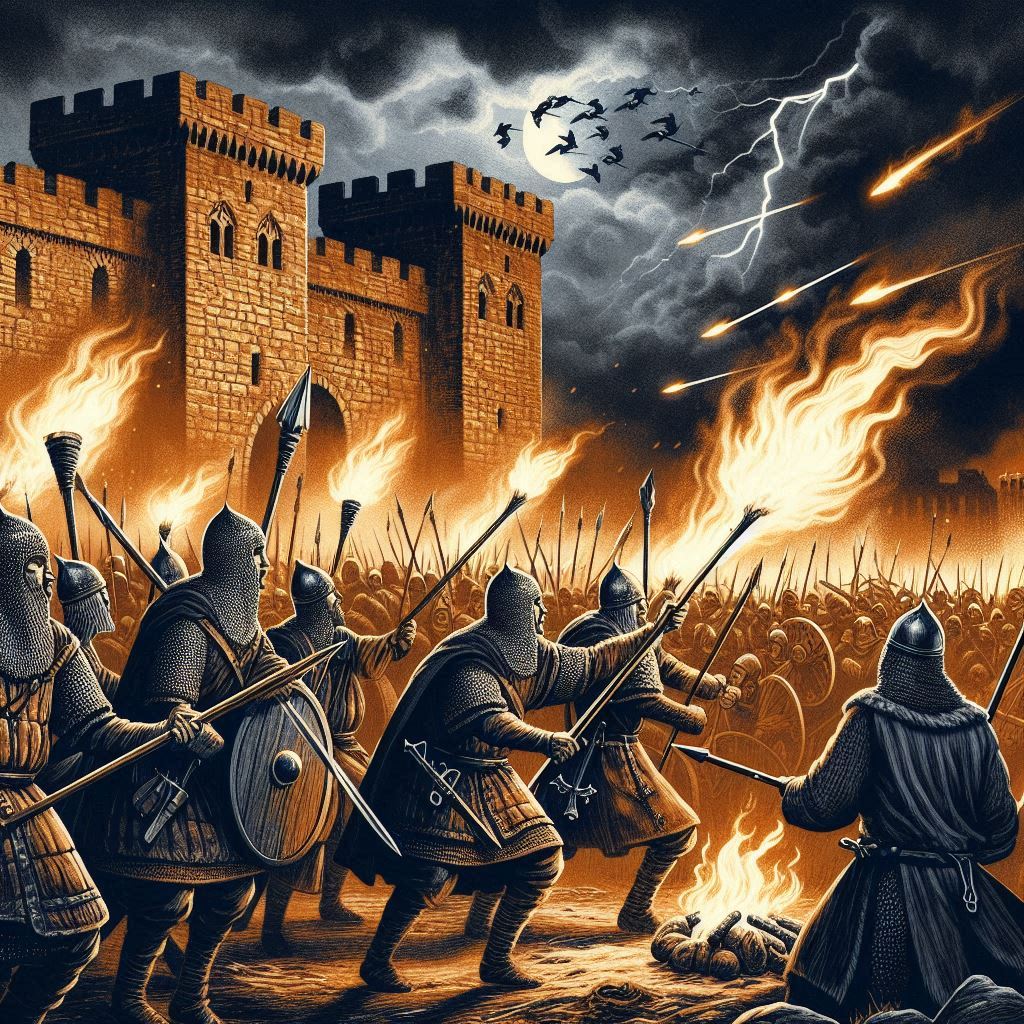
Fire In Human Culture and Development
Fire also played an important role in the development of human culture. It allowed for the creation of social spaces where people could gather around a fire and share stories, music, and knowledge. The fire was also used for religious and spiritual ceremonies, as a symbol of purification and renewal.

As humans evolved and developed more advanced technologies, fire continued to play a central role in our lives. In ancient times, fire was used for smelting metals, allowing for the creation of tools and weapons. The development of the steam engine during the Industrial Revolution was powered by fire, revolutionizing transportation and manufacturing. Today, fire is still used
to generate electricity, heat our homes, and power our cars and airplanes.
The impact of the history of fire on human life cannot be overstated. Fire has allowed humans to survive and thrive in a world that can be harsh and unforgiving. It has enabled us to cook food, stay warm, and communicate with one another. Fire has also been a source of inspiration for artists and writers throughout history, serving as a metaphor for passion, creativity, and destruction.
Conclusion
While fire has been a boon to humanity, it has also been the cause of great destruction. Wildfires, arson, and accidental fires have caused immense damage to homes, businesses, and natural landscapes. Fire safety and prevention are important considerations for modern society, as we strive to balance the benefits of fire with its potential risks.
In conclusion, the invention of fire was a turning point in human history, marking the beginning of our journey toward civilization. It has changed our lives in countless ways, from allowing us to cook our food and stay warm, to powering the machines by combustion of coal, natural gas & oil produces energy that drives our modern world. Fire is a powerful and essential force, Fire can be used both productively and destructively force and we must continue to use it responsibly considering its potential dangers.
Also, Check out interesting blogs-




